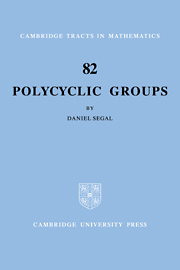Book contents
- Frontmatter
- Contents
- Preface
- Notation
- 1 The elements
- 2 Mal'cev's theorems
- 3 Extensions
- 4 Arithmetical methods
- 5 Faithful representations
- 6 On unipotent groups
- 7 Semi-simple splitting
- 8 Soluble ℤ-linear groups
- 9 A finiteness theorem
- 10 Polycyclic groups with isomorphic finite quotients
- 11 Examples
- Appendix: further topics
- References
- Index
- Frontmatter
- Contents
- Preface
- Notation
- 1 The elements
- 2 Mal'cev's theorems
- 3 Extensions
- 4 Arithmetical methods
- 5 Faithful representations
- 6 On unipotent groups
- 7 Semi-simple splitting
- 8 Soluble ℤ-linear groups
- 9 A finiteness theorem
- 10 Polycyclic groups with isomorphic finite quotients
- 11 Examples
- Appendix: further topics
- References
- Index
Summary
It is easy to construct polycyclic groups, and in this final chapter I shall describe various ways of doing so which illustrate points discussed so far. In a way, this chapter may be seen as a continuation of Chapter 4, section B: to construct groups with specified properties, we must in each case elucidate the arithmetical meaning of those properties, and then have to solve the resulting problem of number theory.
Section A constructs non-isomorphic polycyclic groups with isomorphic finite quotients; the simplest examples of these are directly related to algebraic number fields with class number greater than 1. In section B we consider groups which do not split over their Fitting subgroup, hence cannot be isomorphic to arithmetic groups.
The rest of the chapter concentrates on torsion-free nilpotent groups of class 2. These groups have a particularly simple description in ‘arithmetical’ terms, which is explained in section C. Those of Hirsch number at most 6 can be completely classified, in terms of equivalence classes of binary integral quadratic forms. This classification is given in section D; it illustrates a theme which I have tried to bring out throughout the book, by isomorphically embedding a small segment of the theory of polycyclic groups into an interesting and classical branch of number theory.
Finally, section E discusses unitriangular groups of matrices over rings of algebraic integers.
Information
- Type
- Chapter
- Information
- Polycyclic Groups , pp. 255 - 278Publisher: Cambridge University PressPrint publication year: 1983
